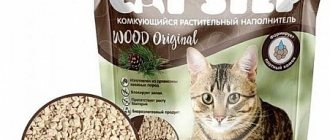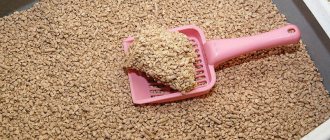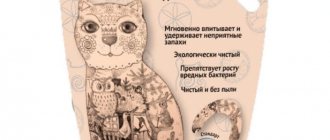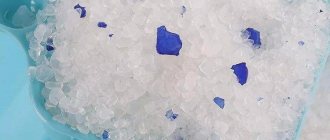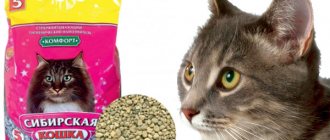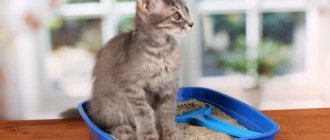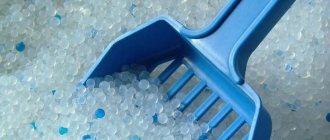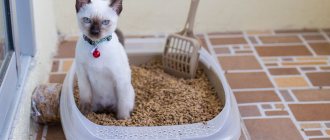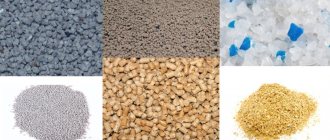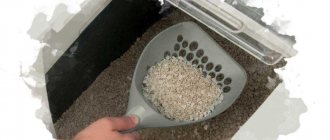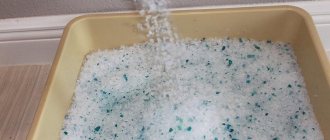Today, pet stores, supermarkets and veterinary pharmacies have a wide range of cat litters - from wood to silica gel. At first glance, it may seem that the costs of the material are insignificant, but still they are constant and noticeable for any average pocket. And if there is an opportunity to save, then why not take advantage of it? And you can do this with the help of the following five unexpected, but very good fillers.
Why do you need filler?
Cat litter performs several functions at once: - absorbs moisture (dampness in the litter box can cause the cat to stop using it);
- absorbs unpleasant odors; — allows the animal to realize its natural desire to “bury” excrement; - simplifies cat care by making litter box cleaning less frequent. If a cat does not want to “hide” traces of its vital activity, you can do without any filler at all by installing a tray with a grid: all the moisture will drain to the bottom. True, in this case you need to constantly monitor the condition of the tray, try to rinse it after each use and wash it thoroughly at least once a day - otherwise the stench cannot be avoided. If such careful control of the tray is not possible, you will have to resort to one of the “folk” options for fillers.
Regular sawdust from a sawmill
You can replace purchased fillers with regular sawdust. They are 100% natural, which means they will not cause any harm to the health of your beloved pet.
In addition, sawdust absorbs moisture well. After absorbing liquid, they do not crumble, which means that the area around the pot will be clean and tidy.
If we talk about cost, then you can get sawdust completely free of charge or for a penny per bag. For example, at a nearby sawmill.
See also:
7 cheap cat litters that are better than expensive ones
Sand
Sand absorbs moisture quite well. It copes with the smell somewhat worse: it weakens it, but does not absorb it completely. Therefore, if you use sand as a filler, you will have to come to terms with the fact that the toilet will almost always smell like cat urine. In addition, the grains of sand are very light - therefore, when the animal buries traces of its vital activity, the floor next to the tray will be covered with sand. However, this trouble can be avoided by using high trays with sides. The sand in the cat litter box is replaced every 2-4 days.
Why is there a mesh in the cat tray?
Among the wide range you can choose rectangular, oval and corner models. With a door, a carrying handle, even a carbon filter. It is advisable that the chosen “nook” for the cat be equipped with a special mesh.
The main purpose of the grill is to protect the animal from dirt. Liquid excrement seeps through the mesh. Hard ones will remain on top: just pull out the removable part and rinse under running hot water.
Many owners choose containers without a mesh, justifying the purchase based on the cat’s physiology:
- It’s inconvenient to drive your claws across plastic;
- feces remain on the mesh - which means the cat will still get its paws dirty, trying to bury the waste.
Then they are forced to buy a removable side that prevents the animal from scattering sand or granules, and a small rug on which the pet wipes its paws. Another reason to choose a litter box with mesh is that the mesh will prevent your cat from eating the kibble.
Newspapers
Newspapers torn into small pieces are an old “folk” way of arranging a cat’s litter box, very popular, but at the same time quite troublesome. To make it convenient for your cat to use the tray, you need to tear the paper quite finely, but it gets wet very quickly. You have to change the paper in the tray every day, or at most every other day, and it doesn’t cope with the smell very well.
You can buy a tray with a grid - then the moisture will flow down and the newspapers will get wet more slowly. To avoid odor, such a tray should be emptied several times a day.
How to equip a toilet for a kitten - choose a tray and place
The first thing is to buy a tray. You need to save money and buy a specialized litter tray that has high sides to prevent debris from scattering when feces are buried in the litter.
Of course, there are cheap options, for example, low plastic pallets with a pallet grid at the bottom, and you can come up with some kind of cat toilet room yourself using improvised materials. But they will be uncomfortable for the cat, and she will begin to avoid relieving herself in the right place.
A deep tray that holds a large amount of litter allows the cat's instincts to work. The animal will happily dig into the litter, dig a hole, use it for its intended purpose and bury excrement. In this case, no specific training of the kitten will be needed - instinctive behavior will work.
Which tray is better to choose for a cat's litter box? Breeders begin toilet training kittens from the age of three weeks, at which point the mother cat ceases to provide them with this need. First, place a shallow plastic container into which fine filler is poured.
For kittens, it's more like a game, until the smartest one learns to dig holes. As soon as one kitten has a proper bowel movement, the rest will do the same.
Sawdust
Sawdust is a good alternative to factory-made fillers. They are easy to dig, they retain both moisture and smell well - such a tray begins to smell only when all the sawdust becomes wet. Therefore, sawdust is one of the best types of “folk” fillers. If you use a tray with high sides and sprinkle sawdust in a layer of 8-10 centimeters, you can clean the cat litter box every 5-7 days. True, there are also some inconveniences: sawdust generates dust, in addition, the smallest particles of wood “stick” to the cat’s paws and are spread throughout the apartment.
You can place a thin layer of pieces of newspaper on top of the sawdust - then there will be less dirt on the floor. Wet paper should be changed daily.
Dry grass, hay
Even in the city it is not difficult to make such a filler. In the low corners of each park there is thick grass - you need to collect it, choosing something that is soft to the touch, without hard and brittle stems. Dry the herb in the shade by spreading it in a thin layer on a flat surface covered with newspaper or cloth. When everything is completely dry, collect in a fabric bag and store in a dry, ventilated place. Animals love this type of litter. If it is not possible to collect grass with your own hands, it is worth purchasing hay - in pet stores it is sold as food for rodents.
Fuel granules (pellets)
Wood pellets intended for solid fuel boilers are wood processing waste pressed into granules and are practically no different from wood fillers for cat litter. When wet, they crumble into small sawdust and absorb moisture and odor just as effectively. The pellets are poured into the tray in a thin layer; as they are used, their volume increases 4-5 times. If you use pellets, you can clean the tray once every 7-10 days.
Cat litter box device
What is this design?
- First of all, it is a convenient and stable device made of plastic. The cat litter box cannot be made of wood or iron, because iron, due to exposure to urine, will oxidize and release fumes that are hazardous to health. Wood is also not used for these purposes, since it absorbs moisture very well, and it will breed harmful microorganisms that can cause harm not only to animals, but also to people. Plastic does its job very well. This device is quite lightweight and can be easily moved to anywhere in the apartment.
- The grate, which is placed on top of the tray, is quite comfortable for the cat's paws, allowing the cat to do his business without difficulty.
It is better to take a tray “for growth”, focusing on adult cats, this is necessary so that then a situation does not arise where an adult cat has to be taught to use the tray again.
HOW TO TRAIN A CAT OR A CAT TO A TRAY WITH A GRATE?
Natural instinct makes cats first dig a hole for the toilet, and then bury it. It is clear that there is nothing to dig in a tray with a grate. How to be?
At first - just for training - pour the filler on top of the grate. To keep your cat safe, use natural litter - wood, paper or corn. When the cat gets used to going to the litter box, you can switch to silica gel. And so that the cat doesn’t get confused at the sight of the “new” tray:
- put some already used filler into a bag;
- When adding silica gel for the first time, add old used filler to it.
The cat will come to the familiar smell and understand what to do.
toilet
Comments ()
Log in to leave a comment
WHAT FILLER SHOULD I CHOOSE FOR A TRAY WITH MESH?
The best one is silica gel. At first glance, it is more expensive than other types of fillers (read about them in the article “Which tray filler is best”). But in fact, silica gel “works” longer and is consumed many times slower than wood or clay granules.
One package of silica gel filler, when used in a tray with a grid, will last you a long time. For a very long time!
Silica gel has its drawbacks: its granules can prick unpleasantly, crunch, get stuck in the paw pads, and stain the fur. Swallowing them is like swallowing concrete. But in a tray with a grid, all these disadvantages do not matter, because the cat does not touch the filler at all.
How to use filler correctly?
Once you have a cat in your home, it is important to train him to use the litter box. But in order for the learning process to be successful, the owner is responsible for choosing the filler. Of course, it is not a fact that you will be able to choose the composition correctly the first time and train the animal. The cat litter box can be located in any convenient place. But the cat should feel comfortable there.
- Pour a small amount of litter into the tray. Depending on its type, the thickness can vary from 3-4 cm for wood and sand gel to 2-3 cm for silica gel;
- When replacing the litter, pets may initially show reluctance to go to the previous litter box. Retrain the animal gradually;
- You can pour the filler both on the mesh and on the pallet. Most modern formulations take into account the importance of cleanliness. Therefore, many of them do not stick to their paws.
It is not difficult to choose a high-quality filler. The most important thing is to be patient while learning. Let your cat know that the litter box is for him and he can use it. Odors from the cat litter box will not spread into the house if you change the contents of the litter box in a timely manner. Keep in mind that some litters require replacing lumps, others require more frequent cleaning. But keeping your cat clean is also important. In addition, the cat mostly does the bathing and grooming itself. This means that all you have to do is feed him on time, ensure the cleanliness of the toilet, place to rest and eat. Of course, sometimes you have to help the cat and clean his fur.
HOW TO REMOVE THE TRAY AND HOW OFTEN TO CHANGE THE FILLER?
Cats have a habit of peeing in the same corner of the tray over and over again. If you are too lazy to remove the grill and remove the stuck together lump of filler, just unfold the tray.
If necessary, remove the grill, remove lumps and add fresh filler.
When using silica gel, the tray container can be washed rarely - once every two to three weeks, as needed. But it would be a good idea to wash the grate after each trip “for the most part.”
Fuel pellets as a filler for rodents, in particular for rabbits
No, they should not be used under any circumstances. If a tray with filler is in a rabbit's enclosure or cage, then the filler should be of the highest quality, preferably made specifically for rodents. In fact, the animal breathes this waste.
If a cat spends only a few minutes a day in contact with the litter, then rodents are in contact much more often. And their health and lungs are much weaker.
So pellets for rodents are just a terrible, huge and terrible mistake!
Not to mention the fact that they don’t cope with the task at all, and instead of absorption and a pleasant smell, they give off stench and dirt.
There are special litters for rodents, or cat litters of good quality are suitable. Odorless, well compressed, light in color.
This is interesting:
- Ball Garik Do you think it's just a ball? Nope. This is a real trophy.
